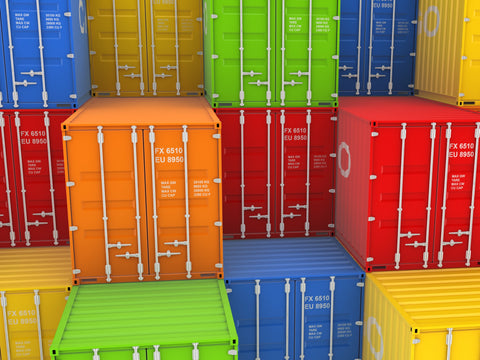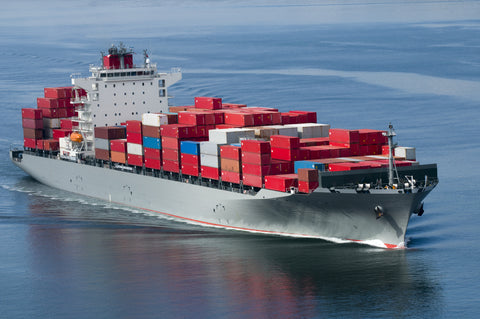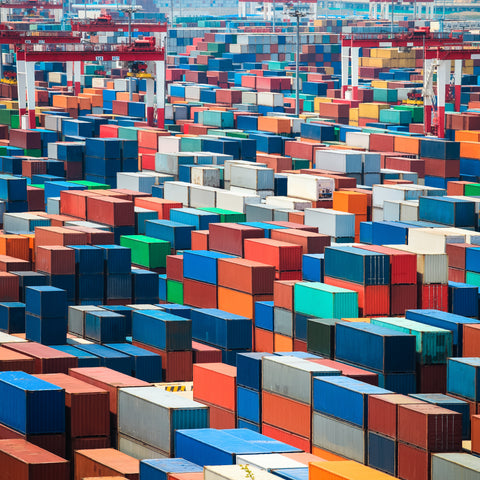The story of the shipping container. Intermodalism & containerization.
In the 1970's a simple invention changed the world. This is the history of the shipping container.
Because of the ubiquity of shipping containers, we take them for granted in today’s society. But you only need to go back 60 years and we had no shipping containers- no intermodal transport systems.

How is it that the world knows the name Henry Ford yet not Malcom McLean? Today we are going to look at the history of shipping containers- what we used before them, how and who invented them and finally, the impact they have had on globalisation and the world as we know it today.
Pre-Shipping Containers
For centuries mankind has voyaged across the seas taking not only themselves but food, cotton, treasure and goods, the likes of which their own country had never seen before. Just think of the Egyptians, Greeks, Romans and more recently the British!
How did they transport their goods around the world? Well they clearly shipped them, but without any standardisation it was a slow and difficult process.
Goods would be stored at a port warehouse until a boat was available. When an empty vessel arrived these goods would be transported from the warehouse to the side of the docked ship. Goods would typically be loaded into sacks, bales, crates and barrels, and then they would be loaded by hand onto the ship. As you can imagine this would be a very labour intensive process. This process was known as break bulk cargo, and a typical ship would have around 200,000 pieces of cargo on-board.

Towards the later part of the second industrial revolution (early 1900’s), this lack of standardisation was becoming a real issue, especially considering how prevalent trains had now become. Transferring cargo from ships to trains was extremely slow and caused major delays and blockages within many ports. Larger ships would take around a week to unload then re-load (Levinson, 2006: The Box: How the Shipping Container Made the World Smaller and the World Economy Bigger).
This was the only way to transport goods and for centuries this process remained unchanged.
Just Who Was Malcom McLean?
There was a great need for a standardised method of transport but for this to be realised a whole host of industries needed aligning, such as: ships, trains, trucks and port terminals. As you can imagine, it would require a lot of work and persuasion to make such a feat possible.
This is where you find out exactly who Malcom McLean is.
Malcom McLean was born in 1914 and grew up on a farm in North Carolina. After finishing school in 1931, he worked for several years to save up enough money to purchase a second-hand truck, and in 1934 he launched his transport business. McLean soon scaled up his transport business and had five trucks running underneath him.
During a routine delivery of cotton bales in 1937 from North Carolina to New Jersey, McLean witnessed stevedores loading and unloading cargo, which took hours on hours, and he contemplated on what a waste of time and money this was.

From 1937 until the start of 1950, McLean focused on his transportation business, which now had over 1750 trucks and 37 transport terminals. In fact it was the fifth largest truck transportation business in the whole of America.
It was during this time period that several weight restrictions and levying fees were introduced to road transportation. It was not uncommon for McLean’s drivers to be fined for heavy loads of cargo.
McLean was now looking for a more efficient way to transport his clients’ cargo and was reminded of his experience in New Jersey back in 1937. It was now when he had the idea of creating a standard sized trailer which could be loaded onto boats in the volume of not one or two, like with his trucks, but in hundreds. He envisaged revolutionising his transportation business by removing most of his trucks and using boats to transport the goods to ‘strategically’ place trucking hubs.
This would mean that trucks would only be used for short, intrastate, deliveries. Hence eliminating the weight restrictions and levying fees which had only recently been introduced.
The Birth of a New Era: Intermodalism
McLean, convinced by his idea to create a standardised shipping ‘trailer’ or container, sold his trucking business and in 1955 took out a bank loan for $42million. He used $7 million of this loan to purchase an already established shipping company: Pan-Atlantic Steamship Company. Pan-Atlantic already had docking rights in many of the eastern port cities which McLean was targeting and shortly after buying them he renamed it to SeaLand Industries.
McLean then went on to test variations of the container and finally settled on a primitive form of what we know today as the shipping container. It was strong, standardised, stackable, easy to load/unload and lockable (which made it theft resistant).
So now McLean had his containers, the final piece of the jigsaw was designing ships which could hold the containers. He bought the oil tanker, Ideal X, and modified it to hold 58 of his newly designed containers, in addition to 15,000 tons of petroleum.

On the 26th of April 1956 Ideal X left New Jersey, heading for Houston. The success of his design was reinforced when the company was taking orders before the ship even docked in Houston to take goods back to New Jersey. This was mainly due to McLean being able to offer 25% discount off the price of conventional cargo transportation at the time. Also because the containers were lockable, it stops goods from being stolen during transit.
The Expansion of Shipping Containers
Following the success of Ideal X’s maiden voyage, McLean ordered the first ever ship specifically designed to carry containers: Gateway City.
Gateway City’s first voyage was in October 1957, and went from New Jersey to Miami. Incredibly it only required two groups of dockworkers to unload and load the cargo. The cargo could be moved at a staggering 30 tons per hour, unheard of at the time.
Standardisation
At this point, McLean was using 33 foot containers- opposed to the 20 and 40 foot containers which we see today.
However there was still the issue of a lack of standardisation with regards to the container’s size and corner fittings. This standardisation was needed so containers could be stacked effectively. Also trains, trucks and other transport equipment required a standard sized container so each method of transport could be built to a single size.
During the Vietnamese war the US government were looking for a way to ship goods more efficiently and were pushing for standardisation. McLean’s SeaLand Industries were still using 33 foot containers whereas industry rival Matson’s were using 24 foot containers. McLean agreed to release his patent of the revolutionary shipping container corner posts (vital to its strength and stacking) and several standards were agreed.
- January 1968: ISO 338 defined the terminology, dimensions and ratings.
- July 1968: ISO 790 defined how containers should be identified.
- October 1970: ISO 1897 defined the recognised sizes of the containers.
As a result of these standards we now have the 20 foot and 40 foot shipping containers (see our blog post on shipping container dimensions for more information). In fact 20 foot containers, called Twenty foot Equivalent Unit (TEU), went on to become the industry standard for referencing cargo volume.

Resistance
The final stage to shipping containers spreading worldwide was the resistance at ports due to the widespread redundancies caused by containers.
As we spoke about earlier on in the article, traditionally, the process of loading cargo required lots of port workers to physically manhandle all of the goods into position. However with containers these workers were no longer required, which caused outrage with the dockside unions. During the early 1970’s many union workers went on strike, disrupting the shipping industry and shipping container’s rapid expansion.
However, due to the huge financial savings of containerised shipping, these union workers were paid severance agreements and shipping containers’ growth sky-rocketed.
As a result, by 1970, SeaLand Industries had 36 container ships, twenty-seven thousand containers and connections to more than 30 ports in America.
McLean then sold the company to R.J. Reynolds for $160 million.
For more information on Malcom McLean click here.
Shipping Containers: Legacy
It took a mere 10 years for the first every international container ship voyage. In April 1966, Sea-Land’s Fairland sailed from the US to the Netherlands with a whopping 236 containers on-board.
From here container ships saw a massive expansion, and in 1968 container ships had the capacity to carry around 1,000 TEUs- this was exceptionally large at the time.
Many now claim containers have been the single largest driver in globalisation over the last 60 years.
- The cost to ship cargo has dropped more than 90%.
- In 1956 cargo cost $5.86 per ton to load whereas now it only cost around $0.16 per ton.
- In 1966 around 1% of countries had container ports, this rose to 90% by 1983.
- Malcom McLean has been awarded ‘Man Of The Century’ by the International Maritime Hall of Fame.
- Pre-containers, cargo could be loaded at around 1.3 tonnes per hour. This increased to over 30 tonnes per hour by 1970.
- In 2011 the shipping ports of America received $1.73 trillion worth of goods.
- Around 90% of every purchased item has been shipped inside a container.
- There are more than 17 million shipping containers in the world, which make over 200 million trips per year.
- A sweater can now travel 3,000 miles for 2.5 cents by sea.
- There are more than 6,000 container vessels currently in service.
- The largest shipping in the world, MSC Oscar, has a TEU of 19224: source.
Wow, how about that! I bet you didn’t know that the humble shipping container experienced such an interesting beginning! Who knew that what we are now using to build our homes with changed the world so much…
Let me know in the comments below if you have any incredible facts about Shipping Containers in the 21st Century !
by Tom Woods Checkout his book: How to build a shipping Container Home
